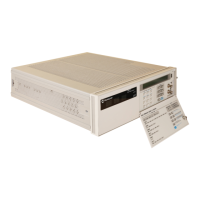Appendix A Performance Tests
5071A Complete Performance Tests
150 Operating and Programming Manual
Procedure
If you are using the HP/Agilent 3585B Spectrum Analyzer, follow the steps
below to test for harmonic signals on the 1 MHz output. If you are using a
different spectrum analyzer, use these steps as a guide for operation of that
analyzer.
1 Connect the 5071A 1 MHz output to the 3585B Spectrum Analyzer as shown in
Figure A-5. Set the 3585B for 50 input impedance.
2 On the 3585B, perform the following steps:
a. Press the green INSTR PRESET button and allow the analyzer to go through
its auto range algorithm (this will take about 5 seconds).
b. Press the STOP FREQ button. Then set the stop frequency to 20 MHz using
the numeric and unit keys in the entry menu.
c. Press the DSP LINE button and move the display line to -40.0 dBc.
d. Press the PEAK SEARCH button, then the MKR->REF LVL button.
e. When the new sweep has passed through the fundamental frequency, press
the OFFSET and the ENTER OFFSET buttons in the marker menu area.
Verify that both the offset frequency (Hz) and the offset level (dB) go to zero
(0 Hz and 0 dB should be displayed at the top of the screen). If necessary,
press and hold the ENTER OFFSET button to zero-out the marker offsets.
f. When at least one sweep has completed, verify that there are no signals on or
above the -40 dBc display line at multiples of 1 MHz up to 4 MHz. Use the
knob in the marker area to move the offset marker to any signals within this
range if you want to measure or record these signals. The marker shows the
offset frequency and level in dBc from the 1 MHz signal.
3 Record the actual reading in the appropriate place in the Performance Test
Record.

